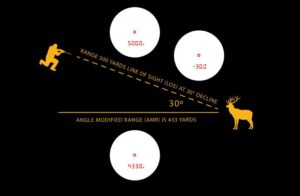For some hunters, a rangefinder is indispensable. To others, it’s a luxury. Whichever camp you’re in, there’s no denying that knowing the distance to your target is paramount to making a clean, swift kill.
The Process
When you push the button on a rangefinder, it shoots an infrared laser, which hits an object and bounces back. The rangefinder’s computer uses the time it takes for the laser to travel to the object and back to calculate how far the object is to you.

Most rangefinders today come with an inclinometer that takes the guesswork our shooting at angles, recalibrating the distance to account for slope.
The Laser
Many rangefinders on the market today can reach out to 1200 yards! Are you going to shoot an elk that far? Hopefully not, but the ability of a laser to range an animal at that kind of distance means the laser’s divergence, or the amount the beam spreads out over distance, is reduced. More expensive rangefinders will feature divergences as low as 1.5 meters while less expensive rangefinders are 2-3 meters wide. In essence, the more energy that gets to the target, the more accurate the reading. A more effective laser also will cut through rain, snow, grass, twigs and other environmental “noise” that could impact longer readings.
LCD vs LED
Liquid crystal displays (LCD) appear black inside the lens as they indicate yardage. They are fine for sunny days because they only transmit about 20-30 percent of available light. But at dusk and dawn when light is faint, a light-emitting diode (LED) display is red and projected onto the lens, which allows light transmission at up to 80 percent. LED models are typically more expensive.
Scan Mode
When rangefinders first hit the hunting market, users found their target, pushed a button and got a reading, which is great if elk are on a barren hillside. But now, hunters can hold the button down and get a continuous distance reading. Users walk the laser through brush to get a clear reading on the actual target, rather than trees or other obstacles that might produce inaccurate readings.